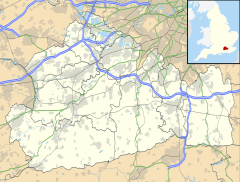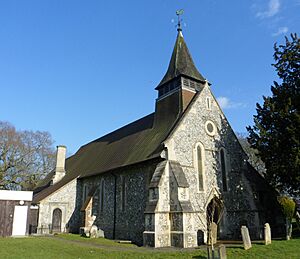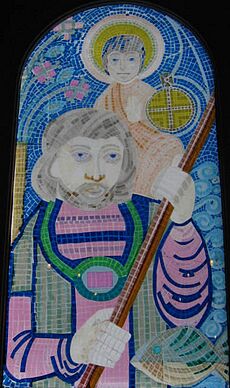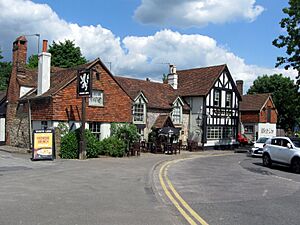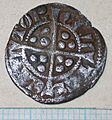Warlingham facts for kids
Quick facts for kids Warlingham |
|
|---|---|
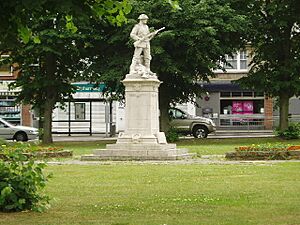 The Green and The War Memorial |
|
| Area | 6.02 km2 (2.32 sq mi) |
| Population | 8,036 (Civil Parish 2011) |
| • Density | 1,335/km2 (3,460/sq mi) |
| OS grid reference | TQ355585 |
| Civil parish |
|
| District |
|
| Shire county | |
| Region | |
| Country | England |
| Sovereign state | United Kingdom |
| Post town | Warlingham |
| Postcode district | CR6 |
| Dialling code | 01883 |
| Police | Surrey |
| Fire | Surrey |
| Ambulance | South East Coast |
| EU Parliament | South East England |
| UK Parliament |
|
Warlingham is a lovely village and civil parish in the Tandridge area of Surrey, England. It's about 14 miles (22 km) south of London and 22 miles (35 km) east of Guildford. Warlingham is the main part of a larger area that includes Hamsey Green to the north. The town of Caterham is just 2 miles (3 km) to the southwest.
Contents
- What's in a Name? The Meaning of "Warlingham"
- A Journey Through Time: Warlingham's History
- Warlingham's Landscape: Geography
- Working Life: Economy
- Fun and Facilities: Amenities
- Learning in Warlingham: Local Schools
- Getting Around: Local Transport
- Staying Active: Sport
- Homes and People: Demography and Housing
- Images for kids
- See also
What's in a Name? The Meaning of "Warlingham"
The name "Warlingham" first appeared as Warlyngham in 1144. The way we spell it today, "Warlingham," was first used in 1198. Over time, people spelled it differently, like Warlinggeham or Werlingham. Most experts agree that the name comes from Old English words. It likely means "the home or homestead of the followers of Wærla."
A Journey Through Time: Warlingham's History
Ancient Times and the Middle Ages
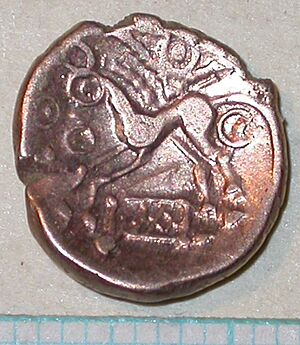
People have lived in the Warlingham area for a very long time. We know this because old stone tools have been found here. In 1909, archaeologists found ancient pots that were used to hold ashes after someone had died. These pots were from a time called the Late Celtic period.
You can also find dips in the ground that might have been "pit houses." These were simple homes dug partly into the earth.
During the time of the Anglo-Saxons, Warlingham was part of a larger area called Tandridge hundred.
Who Owned the Land? Manors of Warlingham
For many centuries, most of the land in Warlingham was owned by three main estates, called manors. These were Warlingham Manor, Crewes/Carewes Manor, and Westhall Manor.
- Warlingham Manor: This manor was given to Bermondsey Priory, a type of monastery, in 1144. They owned it until King Henry VIII closed down the monasteries. Later, a rich merchant named Sir John Gresham bought it. Over the years, it was sold to different families, including the Atwood Wigsell family.
- Crewes Manor: This manor was also owned by several important families over the centuries. It was once part of the Beddington manor. In 1375, the lord of this manor was given special permission to hunt wild animals on his land. Many families, like the Carews, Huscarls, and Saunders, owned it before it was sold many times, eventually to the Smith family by 1911.
- Westhall Manor: King Henry VIII once owned this manor. It was later passed down through families like the Redes and the Claytons. The Claytons also owned another manor nearby called Bletchingley.
The Story of Warlingham's Churches
All Saints' Church is a very old building, dating back to around 1250. It's made from flint stones and has a unique look. Inside, there's a wall painting from the 1500s showing St Christopher carrying Jesus Christ. Some people believe that Archbishop Thomas Cranmer, a very important religious leader, started working on the first English Prayer Book at this church. A stained-glass window shows him giving the Prayer Book to King Edward VI.
The church has special windows called lancet windows and a gabled wooden porch. Over the years, parts of the church have been repaired and restored.
In 1907, a second church was built in Warlingham, called St Christopher's Church. It stands near Memorial Park.
Modern Times: After the Industrial Revolution
In 1841, Warlingham had 512 people living there. A famous inventor, Sir Joseph Swan, who helped invent the incandescent light bulb, lived in Warlingham during the Victorian era. The famous architect Sir George Gilbert Scott helped to restore All Saints' Church in 1857.
Warlingham has several historic buildings. Five old "Coal-tax posts" are important landmarks. These posts marked where taxes were collected on coal coming into London. Six buildings are officially "listed," meaning they are protected because of their special architecture. These include Court Cottage, The Vicarage, some houses on Leas Road, All Saints' Church, The White Lion (a pub), and The Barn. The War Memorial from World War I is also a protected national heritage site.
Warlingham also gave its name to a large hospital that opened in 1903. It was first called "Croydon Mental Hospital" but later became "Warlingham Park Hospital". The hospital buildings were taken down in the early 2000s, and new homes were built there.
During World War II, Warlingham was right under the flight path for many air battles, especially the Battle of Britain. Nearby airfields like Biggin Hill and Kenley were very important for defending London. German bombers often flew through the valley near Warlingham, which was known as 'Bombers' Alley'.
The War Memorial on the village green is a special place. It reminds everyone of the many local people who bravely served and sacrificed during the two World Wars.
Some famous musicians have lived in Warlingham. Joe Strummer, the lead singer of the band The Clash, moved here when his family returned to the UK. Reggae singer Smiley Culture also lived in Warlingham.
Warlingham's Landscape: Geography
Warlingham is located on the side of the North Downs, which are a range of hills. Parts of the village are quite high up, about 650 feet (200 meters) above sea level. This means that when it snows in southern England, Warlingham often gets more snow than lower areas nearby.
Because it's so high, Warlingham offers amazing views of central London on a clear day. You can see famous skyscrapers like Canary Wharf and the Gherkin!
Warlingham is part of the Metropolitan Green Belt, which is land protected from building to keep it natural. Around the village, you'll find beautiful rolling hills and woodlands. Some areas nearby, like parts of the Woldingham valley, are special protected sites for wildlife.
Blanchman's Farm Nature Reserve is a wonderful place set up in 1991. It's a community wildlife area with a restored pond and thousands of native trees. It even has a path for wheelchairs, making it easy for everyone to enjoy nature.
How High is Warlingham? Elevations
The height of the land in Warlingham changes. It's about 110 meters (360 feet) above sea level at the lowest point in the parish, near Woldingham Road. As you go through the village along the main road towards the southeast, the land gets higher. The highest point is about 199.6 meters (655 feet) at Limpsfield Road.
Working Life: Economy
Today, many people who live in Warlingham travel to work in Croydon or central London. This makes Warlingham part of the "London commuter belt," meaning it's a place where people live and travel to London for their jobs.
Fun and Facilities: Amenities
Warlingham has a lovely village green in the center, shaped like a triangle and lined with trees. The War Memorial stands proudly on the green. Around the green, you'll find many useful shops, like supermarkets, a pharmacy, a hardware store, and hair salons. There are also estate agents, a solicitors' office, and a newsagent.
The village hall is also on the green, along with some charming old cottages, gift shops, and restaurants. Just south of the green is School Common, an open area perfect for recreation. It has a special wildlife pond called Willeypit or Willey's Pit pond, and some old Alms Houses.
A short walk from the green is the community library. It's open most days and offers services like laminating and printing.
Warlingham used to have four pubs, which are places to eat and drink. This was a lot for a village! The 'White Lion' is an old coaching inn. The reason for so many pubs was that nearby villages like Sanderstead and Woldingham didn't have any. Recently, some pubs have changed. The Leather Bottle is now a Turkish restaurant, and the Hare & Hounds is a spaghetti restaurant. So, today, the White Lion and The Horseshoe are the remaining pubs.
Warlingham also has a large Sainsbury's supermarket. It was built on the site of an old London Transport bus garage.
Learning in Warlingham: Local Schools
- Warlingham School is a senior state school with a Sixth Form. It's actually closer to Hamsey Green and shares a campus with Hamsey Green Junior and Infant schools.
- Warlingham Park School is a smaller private school. It's very close to Chelsham Common.
- Warlingham Village Primary School is on Farleigh Road. It used to be called "Farleigh School."
- There are also several private schools nearby, including Caterham, Woldingham School for Girls, Croydon High, Whitgift, and Trinity.
Getting Around: Local Transport
Warlingham is lucky to have two railway stations, even though they are on different train lines. This happened because two different private companies built railway lines to this area a long time ago.
Upper Warlingham railway station is about a mile from the village. From here, you can catch fast trains to London Victoria and London Bridge. You can also go to East Grinstead and Uckfield. There used to be another station called Warlingham on a different line, but it was renamed Whyteleafe South in 1956.
Just a few minutes' walk from Upper Warlingham is Whyteleafe railway station. Trains from here are a bit slower, but they go to London and Caterham every 15 minutes.
The village also has bus services. London Buses route 403 and Metrobus routes 409 and 411 connect Warlingham to places like Croydon, Caterham, Redhill, and East Grinstead.
Staying Active: Sport
Warlingham has a local Non-League football club called Warlingham F.C.. The Warlingham Sports Club is very old, dating back to 1856. It includes clubs for squash, racketball, cricket, and tennis, all of which are very active.
Warlingham is also home to the Warlingham Rugby Football Club, which started in 1922.
Homes and People: Demography and Housing
| Output area | Detached | Semi-detached | Terraced | Flats and apartments | Caravans/temporary/mobile homes | shared between households |
|---|---|---|---|---|---|---|
| (Civil Parish) | 1,154 | 1,182 | 283 | 708 | 38 | 0 |
In Warlingham, about 28% of homes are detached houses, and about 22.6% are apartments.
| Output area | Population | Households | % Owned outright | % Owned with a loan | hectares |
|---|---|---|---|---|---|
| (Civil Parish) | 8,036 | 3,365 | 43.6% | 38.5% | 602 |
In the civil parish of Warlingham, 43.6% of households own their home completely (without a mortgage). Another 38.5% own their home with a loan. These numbers are higher than the average for the wider region, showing that many people in Warlingham own their homes. The rest of the homes are rented.
Images for kids
See also
 In Spanish: Warlingham para niños
In Spanish: Warlingham para niños


